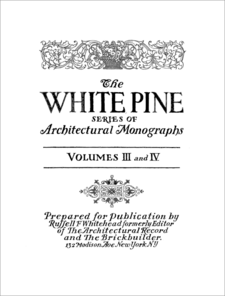White Pine Series of Architectural Monographs

The White Pine Series of Architectural Monographs, subtitled "A Bi-Monthly Publication Suggesting the Architectural Use of White Pine and Its Availability Today as a Structural Wood", was a landmark publication of drawings, photographs and descriptions of early American architecture. The series was launched in 1914 as an advertising campaign by the White Pine Bureau, a joint venture of the Northern Pine Manufacturer's Association of Minnesota, Wisconsin and Michigan and the Associated White Pine Manufacturer's of Idaho. Architect Russell F. Whitehead was hired to supervise the series with Julian Buckly as photographer.
During the first ten years, the series was limited to the exterior details of residences constructed with Eastern white pine, as suited its advertising purpose. Often the notable structures of a single village would be documented together in one issue. By 1920 the editor's collection of unpublished photographs became so extensive that Whitehead and his colleague Hubert Ripley invented the fictional town of Stotham, Massachusetts to justify their use. The fiction went undiscovered until the late 1940s when Leicester Holland, head of the Library of Congress' Department of Fine Arts related his inability to locate the town to Whitehead, eliciting an explanation of the subterfuge.[1]
In 1924 the White Pine Bureau ceased its advertising campaign and Whitehead determined to continue the series independently, selling advertising space to Weyerhauser Forest Products. He also modified the focus of the series, including documentation of churches and public buildings and the recording of interiors and millwork details He also expanded the geographic scope of the project, documenting buildings in the southern states, many of which had been framed with Southern pine or Cypress.
In 1932 the Monograph series became absorbed into the Pencil Points architectural journal as a regular feature. The documentation of historic structures with photographs and measured drawings complemented the "Comparative Details" feature which published construction details for contemporary projects. The Monograph series was ended abruptly in June 1940. Many of its contributors became involved in the Historic American Buildings Survey.
Eagerly collected by architects and historians, the monographs have been re-issued in bound editions several times. In 1987 the National Historical Society of Harrisburg, Pennsylvania began publishing a series of hardbound books, the Architectural Treasures of Early America, drawn entirely from the White Pine Monographs. They reorganized the individual editions into geographic regions and re-set all the type in order to produce a consistent presentation. They were also able, in many cases, to make use of the original photographs which had been given to Weyerhauser by Whitehead's widow.
In 2006 the Northeastern Lumber Manufacturers Association revived the title for a new series of publications documenting the production and use of Eastern White Pine lumber in construction.[2]
References
- ↑ Harbeson, J.F. (May, 1964). “Stotham, The Massachusetts Hoax, 1920.“ The Journal of the Society of Architectural Historians. 23(2): 111-112.
- ↑ "The Revitalization of a Historical Monograph Series." (2006) Northeastern Lumber Manufacturers Association. Vol. XXVII, No. 1
- Magruder, C. (March, 1963). “The White Pine Monograph Series.“ The Journal of the Society of Architectural Historians. 22(1): pp. 39–41
- Davis, William C. (1987) "Historical Introduction to the Series." Survey of Early American Design, Vol. 1 of Lisa C. Mullins, ed., Architectural Treasures of Early America. Harrisburg, Pennsylvania. pp. 5–7
External links
- White Pine Series of Architectural Monographs, Volumes III and IV at Google Books
- Revived monograph series at www.nelma.org
- White Pines Series of Architectural Monographs Collection at Historic Charleston Foundation